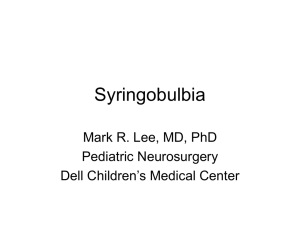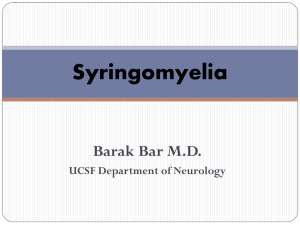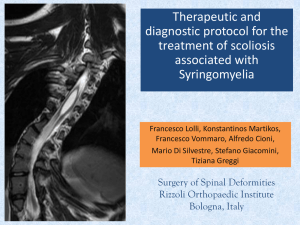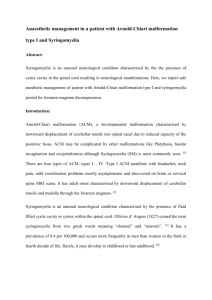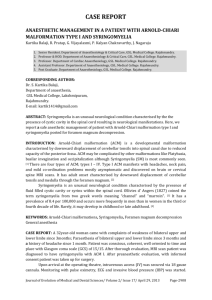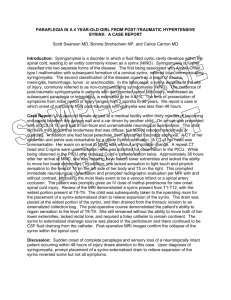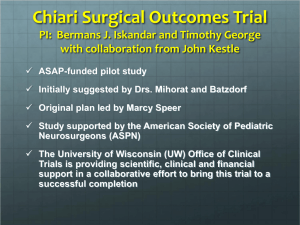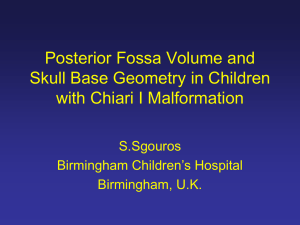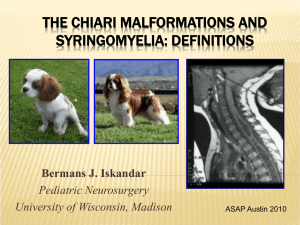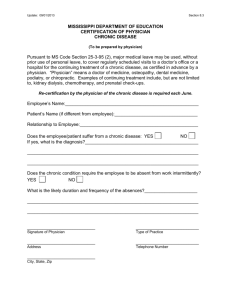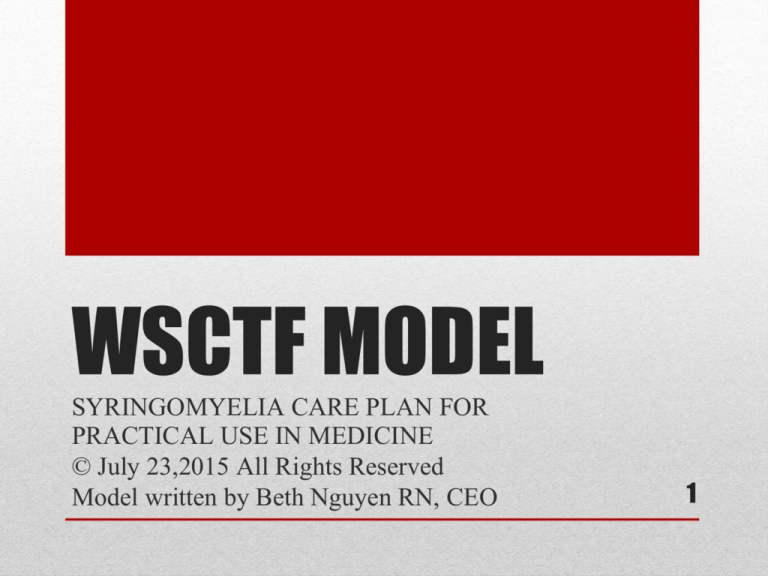
WSCTF MODEL
SYRINGOMYELIA CARE PLAN FOR
PRACTICAL USE IN MEDICINE
© July 23,2015 All Rights Reserved
Model written by Beth Nguyen RN, CEO
1
· Syringomyelia is a disease that is hallmarked by cysts
that form inside the spinal cord and expand. The
presence of the cysts also termed syrinxes can cause
spinal cord and spinal nerve damage leading to
widespread physical symptoms and organ damage.
· This disease has caused paralysis and death.
Time for an action plan
2
· PRIMARY CARE PHYSICIAN/PEDIATRICIAN-this is most often
the patient’s first contact. Individuals typically present with
complaints of neck and/or back pain unrelieved with OTC medicines.
They may also present with sporadic widespread physical symptoms.
Once testing is completed to rule out traditional reasons for the
back/neck pain as determined by the physician consider
Syringomyelia. If patient symptoms persist consider MRI of the
brain and spine to rule out Syringomyelia.
· HISTORY-A detailed medical history is important along with a
physical assessment. Suspect Syringomyelia if the child or adult has
a history of scoliosis, chiari, meningitis, myelomeningocele,
hydrocephalus, spina bifida, trauma such as an MVA, or genetic
background positive for Syringomyelia or Chiari.
· MRI-positive for Syringomyelia or Chiari—consult Neurosurgery.
STEP ONE
3
· NEUROSURGERY—determine if the patient with
Syringomyelia has Chiari or tethered cord and if so determine
need for surgical intervention using decompression or shunting
as a means to slow progression and improve symptoms.
· Consider ordering serial MRI’s to monitor patient over time
and sooner if needed.
· Consider at this time if the patient is having symptoms of
intracranial hypertension such as headaches, dizziness,
whooshing in ears) If so consider consult with neuroopthalmology (See step three).
· Post-surgery-Consider if patient is having chronic neurological
symptoms (ex: numbness,tingling) consult with neurology as
well for EMG study and any other appropriate testing. (See
step four).
4
· NEURO-OPTHALMOLOGY-important part of the team
for Syringomyelia to assess for papilledema. Papilledema
can lead to blindness and this is commonly associated
with intracranial hypertension. IIH is associated with
Syringomyelia and should be ruled out. Vision loss is
important to catch early on.
· The neuro-opthalmologist should work closely with the
neurosurgeon and neurologist to intervene when
necessary to prevent blindness in the children and adults
that are affected.
STEP THREE
5
· NEUROLOGY-important role for medical management.
In a patient who is not a surgical candidate consider the
syrinx as the cause of symptoms whether large or small.
Syringomyelia is complex because of the spinal nerves
damaged causing widespread symptoms with moderate to
severe pain.
· Neurological symptoms can include headache, dizziness,
rapid eye movement, atrophy of tongue with difficulty in
swallowing and speech, numbness, tingling, and burning
to extremities, difficulty walking, and loss of fine motor
skills.
STEP FOUR
6
· PRIMARY CARE PHYSICIAN/PEDIATRICIAN-LONG
TERM MEDICAL MANAGEMENT. Syringomyelia has
many widespread symptoms that require long term medical
management.
· For the remaining specialists required to treat Syringomyelia
the Primary Care physician and Pediatrician are responsible for
making decisions on the appropriate plan of action and
specialist consulted depending on the symptoms. We have
already covered the most obvious physicians who have been
utilized in the past. However, these are some you may not
have considered. Consider step 6!
· **Primary Care and Pediatricians please remember that
syrinxes large and small can cause symptoms!!**
STEP FIVE
7
· PULMONOLOGIST-Syringomyelia can cause difficulty
breathing especially if the individual has syringobulbia which
is a syrinx that affects the brainstem. Consider consulting
pulmonology to follow. Medical evidence has shown that
Syringomyelia has also been associated with heart failure
leading to pulmonary hypertension. Consider the patient,
signs, symptoms, and risk factors.
· Helpful testing can include PFT’s, ABG at rest and with
exertion, and further invasive testing such as invasive
monitoring during a stress test.
· ****Sleep studies are vital on these patients as well because
many have central or obstructive sleep apnea and pass away in
their sleep!*** C-pap may be prescribed as determined by
your treating physician. Oxygen is another option that has
proven useful in some patients and may be prescribed as
determined by your physician.
STEP SIX
8
· CARDIOLOGY—has an integral role. Syringomyelia
has been associated with heart failure, and POTS
dysautonomia. If a patient exhibits symptoms of irregular
heartbeat, shortness of breath, abnormal blood pressures
and heart rates at rest and with exertion, and/or persistent
tachycardia please consult cardiology.
· Patients with Syringomyelia are also at risk of developing
cardiomyopathy from persistent uncontrolled rapid heart
rates from dysautonomia.
· Helpful testing include EKG, cardiac enzymes,
echocardiogram, stress testing, holter monitoring, tilt
table testing, and in some cases a heart catheterization.
STEP SEVEN
9
· ENDOCRINOLOGY—some patients are reporting
abnormal hormone levels, thyroid problems, and other
associated problems with Syringomyelia.
· Individuals with known arachnoid cysts that have been
medically shown to have increased problems with
hormones (estrogen and testosterone production). In
addition abnormal prolactin levels have also been
documented.
· Further research is needed to look at endocrine changes
and Syringomyelia.
STEP EIGHT
10
· GASTROENTEROLOGY—consider GI for persistent
symptoms of nausea, vomiting, constipation or diarrhea.
Many patients with Syringomyelia have impaired motility
of the GI tract secondary to spinal nerve damage.
· Neurogenic bowel is a potential complication of
Syringomyelia.
· In addition patients should not strain for bowel
movements so stool softeners are recommended for those
with chronic constipation.
STEP NINE
11
· UROLOGY-consider this consult for difficulty with
urinating such as difficulty starting/stopping flow of urine
or urinary incontinence.
· Neurogenic bladder can be a problem for patients with
Syringomyelia secondary to spinal nerve damage.
· Consider sexual dysfunction.
STEP TEN
12
· OB-GYN-consider consult for high risk pregnancy for a
woman with Syringomyelia depending on the individual
symptoms as additional specialists may be needed to care
for the patient during pregnancy to manage symptoms.
· Consider sexual dysfunction.
STEP ELEVEN
13
· PAIN MANAGEMENT- ***a pain specialist that
understands the mechanism of Syringomyelia or a
specialist who is willing to learn more about
Syringomyelia should be consulted throughout
management of this disease.***
· Syringomyelia causes moderate to severe pain that is
chronic and at times difficult to treat! This requires a
specialized approach.
STEP TWELVE
14
· PHYSICAL THERAPY-therapy should be performed
under the guidance and collaborative effort of all
physicians involved in your care.
· The therapist should be trained to treat Syringomyelia.
Therapy should be initiated to prevent further weakness
from this disease taking all the patient’s individual
diagnoses into account.
· Our organization is working with orthopedics and
physical therapy to develop a specialized plan of care for
adults and children with Syringomyelia!
STEP THIRTEEN
15
· PSYCHOLOGY-consider the well-being of the individual
with the disease.
· Depression can be an ongoing problem with someone
who has a chronic illness. It may be helpful to speak to a
trained clinician about concerns and ways to cope with
the grief of losing health, family, and friends.
· We offer three support groups for those with the disease,
families & caregivers, and parents with children who
have the disease as resources to assist while living with
the diseases Syringomyelia & Chiari. We encourage you
to join!
STEP FOURTEEN
16
· PALLIATIVE CARE-an important approach in dealing with a long
term chronic disease is palliative care.
· These services can be ordered by your primary care physician to add
to the care you already receive. **It is not hospice care. ** Hospice
is often confused with palliative care. They are separate services.
Hospice is excellent for end of life care. However, when one has a
chronic disease palliative care can be an excellent resource!
· It is a service that would provide additional support to you and your
family on ways to cope with living with a chronic illness. Palliative
care is covered by most insurance plans. Palliative care can be added
as part of your medical support team while continuing your active
treatment plan with your existing physicians.
· In addition services can provide support to your family members and
ongoing support when you are home from the hospital.
STEP FIFTEEN
17
· NURSING APPROACH-nurses working with patients who
have a diagnosis of Syringomyelia should implement a care
plan aimed at the holistic care of the patient. Often times these
patients are complex and require multiple specialists to manage
this disease as it can affect the body head to toe.
· Compassion is required because this disease can cause immense
suffering if not managed effectively. Care plans needed will
depend on the individual patient and body systems affected.
Initial care plans to implement for every single patient with
Syringomyelia when they present for care are :
· Nursing care plan for Spinal Cord Injury
· Nursing care plan for Chronic Pain
STEP SIXTEEN
18

